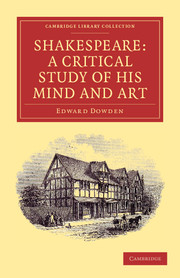Book contents
- Frontmatter
- PREFACE
- Contents
- CHAPTER I SHAKSPERE AND THE ELIZABETHAN AGE
- CHAPTER II THE GROWTH OF SHAKSPERE'S MIND AND ART
- CHAPTER III THE FIRST, AND THE SECOND TRAGEDY; ROMEO AND JULIET; HAMLET
- CHAPTER IV THE ENGLISH HISTORICAL PLAYS
- CHAPTER V OTHELLO: MACBETH: LEAR
- CHAPTER VI THE ROMAN PLAYS
- CHAPTER VII THE HUMOUR OF SHAKSPERE
- CHAPTER VIII SHAKSPERE'S LAST PLAYS
CHAPTER I - SHAKSPERE AND THE ELIZABETHAN AGE
Published online by Cambridge University Press: 29 August 2010
- Frontmatter
- PREFACE
- Contents
- CHAPTER I SHAKSPERE AND THE ELIZABETHAN AGE
- CHAPTER II THE GROWTH OF SHAKSPERE'S MIND AND ART
- CHAPTER III THE FIRST, AND THE SECOND TRAGEDY; ROMEO AND JULIET; HAMLET
- CHAPTER IV THE ENGLISH HISTORICAL PLAYS
- CHAPTER V OTHELLO: MACBETH: LEAR
- CHAPTER VI THE ROMAN PLAYS
- CHAPTER VII THE HUMOUR OF SHAKSPERE
- CHAPTER VIII SHAKSPERE'S LAST PLAYS
Summary
In these chapters an attempt will be made to present a view or aspect of a great poet, and the first word must explain precisely what such a view or aspect is worth, what it professes to be, and what it disclaims. Dr Newman, in his “Grammar of Assent,” has distinguished two modes of apprehending propositions. There is what he calls the real apprehension of a proposition, and there is the notional apprehension. In real apprehension there is the perception of some actual, concrete, individual object, either with the eye or some bodily sense, or with the mind's eye—memory, or imagination. But our minds are not so constructed as to be able to receive and retain only an exact image of each of the objects that comes before us one by one, in and for itself. On the contrary, we compare and contrast.
We see at once “that man is like man, yet unlike; and unlike a horse, a tree, a mountain, or a monument. And in consequence we are ever grouping and discriminating, measuring and sounding, framing cross classes, and cross divisions, and thereby rising from particulars to generals, that is, from images to notions. … ‘Man’ is no longer what he really is, an individual presented to us by our senses, but as we read him in the light of those comparisons and contrasts which we have made him suggest to us. He is attenuated into an aspect, or relegated to his place in a classification. Thus his appellation is made to suggest, not the real being which he is in this or that specimen of himself, but a definition.”
- Type
- Chapter
- Information
- Shakespeare: A Critical Study of his Mind and Art , pp. 1 - 41Publisher: Cambridge University PressPrint publication year: 2009First published in: 1875



